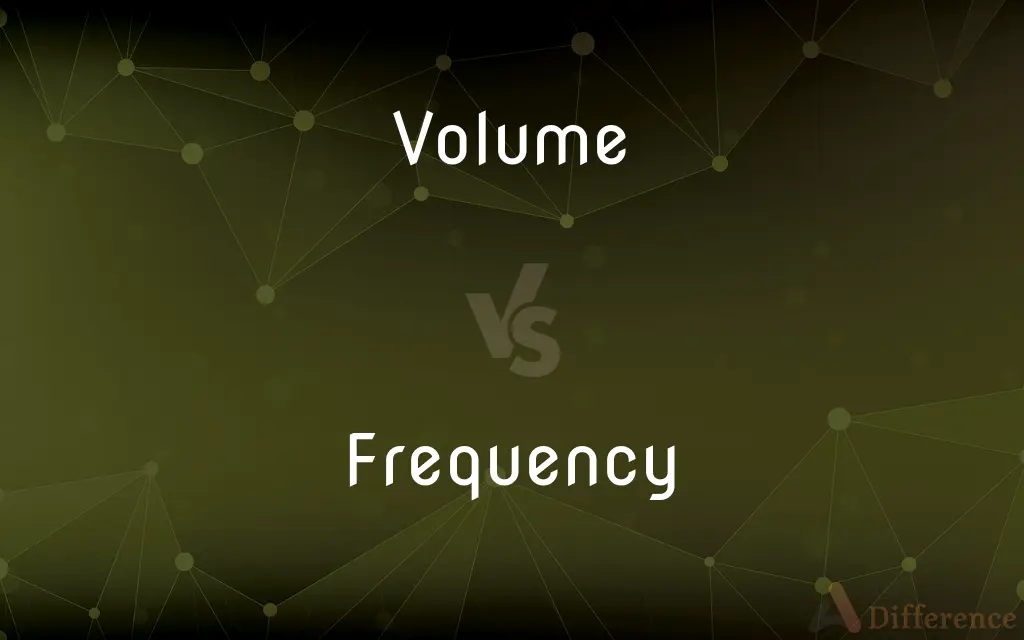Volume vs. Frequency — What's the Difference?
By Maham Liaqat & Fiza Rafique — Updated on May 9, 2024
Volume is the perceived loudness or intensity of sound, while frequency is the rate at which sound waves vibrate, measured in Hertz (Hz), determining the pitch.

Difference Between Volume and Frequency
Table of Contents
ADVERTISEMENT
Key Differences
Volume measures the perceived loudness of a sound, often represented in decibels (dB). Frequency measures how many cycles per second a sound wave completes, affecting the pitch of the sound.
Volume is affected by the amplitude, or height, of the sound wave. Frequency is determined by the wave's speed, influencing whether a sound is perceived as high-pitched (high frequency) or low-pitched (low frequency).
Volume is adjusted by amplifying or reducing the energy of sound waves, making them louder or softer. Frequency is inherent to the source, such as a musical instrument or human voice, and cannot be directly altered without changing the source.
Volume influences how sound interacts with the environment, such as causing echoes or distortions. Frequency determines the tonal quality of the sound, making it musical or noisy.
Volume is adjusted according to listener preference, like turning up music on a speaker. Frequency relates to the type of sound, such as speech frequencies or ultrasound.
ADVERTISEMENT
Comparison Chart
Definition
Perceived loudness or sound intensity
Number of wave cycles per second
Measurement
Decibels (dB)
Hertz (Hz)
Perception
Loud or soft
High or low pitch
Control
Adjusted via amplification
Cannot be adjusted directly
Effect
Alters perceived loudness
Alters perceived pitch
Compare with Definitions
Volume
The perceived loudness or intensity of a sound.
He increased the volume to make the music louder.
Frequency
The property that differentiates types of sound, like music or noise.
The violin produces frequencies different from a flute.
Volume
The level at which sound reaches the listener.
The speaker's volume made every word clear.
Frequency
The rate at which a sound wave vibrates, measured in Hertz.
Dogs can hear sounds with frequencies higher than humans.
Volume
The amount of sound energy passing through a particular area.
The volume in the concert hall was overwhelming.
Frequency
The number of complete cycles per second of a sound wave.
Lower frequency waves produce deeper tones.
Volume
A parameter controlled to amplify or reduce sound output.
Turn the volume down before playing your guitar.
Frequency
A characteristic used in electronic or acoustic signal processing.
Engineers tested the equipment for various sound frequencies.
Volume
A measure of how strong or weak a sound signal is.
They used software to balance the audio volume.
Frequency
A property determining the pitch of the sound.
High-frequency sounds are perceived as shrill or piercing.
Volume
Volume is the quantity of three-dimensional space enclosed by a closed surface, for example, the space that a substance (solid, liquid, gas, or plasma) or 3D shape occupies or contains. Volume is often quantified numerically using the SI derived unit, the cubic metre.
Frequency
Frequency is the number of occurrences of a repeating event per unit of time. It is also occasionally referred to as temporal frequency to emphasize the contrast to spatial frequency, and ordinary frequency to emphasize the contrast to angular frequency.
Volume
A collection of written or printed sheets bound together; a book.
Frequency
The rate at which something occurs over a particular period of time or in a given sample
An increase in the frequency of accidents due to increased overtime
Volume
One of the books of a work printed and bound in more than one book.
Frequency
The rate per second of a vibration constituting a wave, either in a material (as in sound waves), or in an electromagnetic field (as in radio waves and light)
Different thicknesses of glass will absorb different frequencies of sound
Volume
A series of issues of a periodical, usually covering one calendar year.
Frequency
The property or condition of occurring at frequent intervals.
Volume
A unit of written material assembled together and cataloged in a library.
Frequency
The number of repetitions of a complete sequence of values of a periodic function per unit variation of an independent variable.
Volume
A roll of parchment; a scroll.
Frequency
The number of complete cycles of a periodic process occurring per unit time.
Volume
The amount of space occupied by a three-dimensional object or region of space, expressed in cubic units.
Frequency
The number of repetitions per unit time of a complete waveform, as of an electric current.
Volume
The capacity of such a region or of a specified container, expressed in cubic units.
Frequency
The number of measurements or observations having a certain value or characteristic.
Volume
Amount; quantity:a low volume of business; a considerable volume of lumber.
Frequency
See relative frequency.
Volume
OftenvolumesA large amount:volumes of praise.
Frequency
The rate of occurrence of anything; the relationship between incidence and time period.
With growing confidence, the Viking’s raids increased in frequency.
Volume
The amplitude or loudness of a sound.
Frequency
(uncountable) The property of occurring often rather than infrequently.
Volume
A control, as on a radio, for adjusting amplitude or loudness.
Frequency
(countable) The quotient of the number of times a periodic phenomenon occurs over the time in which it occurs: .
Volume
A three-dimensional measure of space that comprises a length, a width and a height. It is measured in units of cubic centimeters in metric, cubic inches or cubic feet in English measurement.
The room is 9x12x8, so its volume is 864 cubic feet.
The proper products can improve your hair's volume.
Frequency
(statistics) number of times an event occurred in an experiment (absolute frequency)
Volume
Strength of sound; loudness.
Please turn down the volume on the stereo.
Volume can be measured in decibels.
Frequency
The condition of returning frequently; occurrence often repeated; common occurence; as, the frequency of crimes; the frequency of miracles.
The reasons that moved her to remove were, because Rome was a place of riot and luxury, her soul being almost stifled with, the frequencies of ladies' visits.
Volume
The issues of a periodical over a period of one year.
I looked at this week's copy of the magazine. It was volume 23, issue 45.
Frequency
A crowd; a throng.
Volume
A bound book.
Frequency
The number of occurrences within a given time period (usually 1 second);
The frequency of modulation was 40 cycles per second
Volume
A single book of a publication issued in multi-book format, such as an encyclopedia.
The letter "G" was found in volume 4.
Frequency
The ratio of the number of observations in a statistical category to the total number of observations
Volume
A great amount (of meaning) about something.
Frequency
The number of observations in a given statistical category
Volume
(obsolete) A roll or scroll, which was the form of ancient books.
Volume
Quantity.
The volume of ticket sales decreased this week.
Volume
A rounded mass or convolution.
Volume
(economics) The total supply of money in circulation or, less frequently, total amount of credit extended, within a specified national market or worldwide.
Volume
(computing) An accessible storage area with a single file system, typically resident on a single partition of a hard disk.
Volume
(bodybuilding) The total of weight worked by a muscle in one training session, the weight of every single repetition summed up.
Volume
(intransitive) To be conveyed through the air, waft.
Volume
(transitive) To cause to move through the air, waft.
Volume
(intransitive) To swell.
Volume
A roll; a scroll; a written document rolled up for keeping or for use, after the manner of the ancients.
The papyrus, and afterward the parchment, was joined together [by the ancients] to form one sheet, and then rolled upon a staff into a volume (volumen).
Volume
Hence, a collection of printed sheets bound together, whether containing a single work, or a part of a work, or more than one work; a book; a tome; especially, that part of an extended work which is bound up together in one cover; as, a work in four volumes.
An odd volume of a set of books bears not the value of its proportion to the set.
Volume
Anything of a rounded or swelling form resembling a roll; a turn; a convolution; a coil.
So glides some trodden serpent on the grass,And long behind wounded volume trails.
Undulating billows rolling their silver volumes.
Volume
Dimensions; compass; space occupied, as measured by cubic units, that is, cubic inches, feet, yards, etc.; mass; bulk; as, the volume of an elephant's body; a volume of gas.
Volume
Amount, fullness, quantity, or caliber of voice or tone.
Volume
The amount of 3-dimensional space occupied by an object;
The gas expanded to twice its original volume
Volume
The property of something that is great in magnitude;
It is cheaper to buy it in bulk
He received a mass of correspondence
The volume of exports
Volume
Physical objects consisting of a number of pages bound together;
He used a large book as a doorstop
Volume
A publication that is one of a set of several similar publications;
The third volume was missing
He asked for the 1989 volume of the Annual Review
Volume
A relative amount;
Mix one volume of the solution with ten volumes of water
Volume
The magnitude of sound (usually in a specified direction);
The kids played their music at full volume
Common Curiosities
Is frequency responsible for sound quality?
It significantly affects sound pitch and tone, impacting overall quality.
Can volume and frequency be changed independently?
Yes, volume can be adjusted without changing the frequency, and vice versa.
Can both volume and frequency be measured?
Yes, volume is measured in decibels, while frequency is measured in Hertz.
Does higher volume damage hearing more than high frequency?
High volume can damage hearing over time, while extreme high frequencies are often inaudible.
Can adjusting volume change the pitch of a sound?
No, changing the volume will not affect the pitch.
Is frequency directly related to volume?
No, frequency determines pitch, while volume determines loudness.
Is frequency important in audio equipment?
Yes, audio equipment is designed to handle specific frequency ranges.
Is volume related to energy?
Yes, higher volume indicates more energy in the sound waves.
What is an ideal volume level for safe listening?
Staying below 85 dB is generally considered safe for prolonged listening.
Why are frequencies important in music production?
Different instruments are blended using frequencies to achieve harmonious compositions.
Do all musical instruments produce the same frequencies?
No, different instruments have unique frequency ranges, contributing to their distinctive sounds.
Is volume perception subjective?
Somewhat, as individuals have varying sensitivities to loudness.
Do humans have a preferred frequency range for hearing?
Humans typically perceive sounds best in the range of 20 Hz to 20,000 Hz.
Can animals hear different frequencies than humans?
Yes, many animals have broader hearing ranges than humans.
Can frequencies beyond human hearing be useful?
Yes, ultrasound and infrasound have scientific and industrial applications.
Share Your Discovery

Previous Comparison
Scholarship vs. Award
Next Comparison
Peat vs. CharcoalAuthor Spotlight
Written by
Maham LiaqatCo-written by
Fiza RafiqueFiza Rafique is a skilled content writer at AskDifference.com, where she meticulously refines and enhances written pieces. Drawing from her vast editorial expertise, Fiza ensures clarity, accuracy, and precision in every article. Passionate about language, she continually seeks to elevate the quality of content for readers worldwide.











































